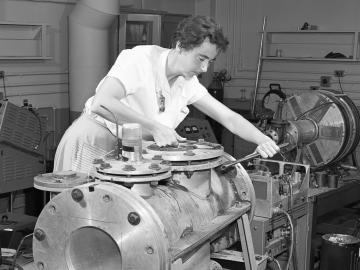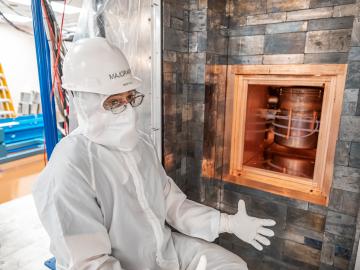
Filter News
Area of Research
- (-) Materials (102)
- (-) National Security (26)
- (-) Supercomputing (107)
- Advanced Manufacturing (22)
- Biology and Environment (60)
- Biology and Soft Matter (1)
- Building Technologies (1)
- Computational Biology (1)
- Computational Engineering (2)
- Computer Science (11)
- Electricity and Smart Grid (3)
- Energy Frontier Research Centers (1)
- Energy Science (144)
- Functional Materials for Energy (1)
- Fusion and Fission (12)
- Fusion Energy (7)
- Isotopes (1)
- Materials for Computing (11)
- Mathematics (1)
- Neutron Science (33)
- Nuclear Science and Technology (15)
- Nuclear Systems Modeling, Simulation and Validation (1)
- Quantum information Science (9)
- Sensors and Controls (1)
News Topics
- (-) 3-D Printing/Advanced Manufacturing (28)
- (-) Advanced Reactors (6)
- (-) Artificial Intelligence (48)
- (-) Exascale Computing (26)
- (-) Grid (15)
- (-) Nanotechnology (42)
- (-) Physics (34)
- (-) Quantum Science (34)
- Big Data (25)
- Bioenergy (20)
- Biology (17)
- Biomedical (22)
- Biotechnology (3)
- Buildings (8)
- Chemical Sciences (32)
- Clean Water (3)
- Composites (9)
- Computer Science (108)
- Coronavirus (19)
- Critical Materials (15)
- Cybersecurity (23)
- Energy Storage (38)
- Environment (39)
- Frontier (32)
- Fusion (9)
- High-Performance Computing (47)
- Irradiation (1)
- Isotopes (14)
- ITER (1)
- Machine Learning (24)
- Materials (80)
- Materials Science (83)
- Mathematics (2)
- Microscopy (29)
- Molten Salt (3)
- National Security (36)
- Neutron Science (43)
- Nuclear Energy (24)
- Partnerships (15)
- Polymers (18)
- Quantum Computing (21)
- Security (15)
- Simulation (16)
- Software (1)
- Space Exploration (5)
- Summit (43)
- Transportation (21)
Media Contacts

The old photos show her casually writing data in a logbook with stacks of lead bricks nearby, or sealing a vacuum chamber with a wrench. ORNL researcher Frances Pleasonton was instrumental in some of the earliest explorations of the properties of the neutron as the X-10 Site was finding its postwar footing as a research lab.

A technology developed at ORNL and used by the U.S. Naval Information Warfare Systems Command, or NAVWAR, to test the capabilities of commercial security tools has been licensed to cybersecurity firm Penguin Mustache to create its Evasive.ai platform. The company was founded by the technology’s creator, former ORNL scientist Jared M. Smith, and his business partner, entrepreneur Brandon Bruce.

For nearly six years, the Majorana Demonstrator quietly listened to the universe. Nearly a mile underground at the Sanford Underground Research Facility, or SURF, in Lead, South Dakota, the experiment collected data that could answer one of the most perplexing questions in physics: Why is the universe filled with something instead of nothing?

A study by Oak Ridge National Laboratory researchers has demonstrated how satellites could enable more efficient, secure quantum networks.

U2opia Technology, a consortium of technology and administrative executives with extensive experience in both industry and defense, has exclusively licensed two technologies from ORNL that offer a new method for advanced cybersecurity monitoring in real time.

Three scientists from the Department of Energy’s Oak Ridge National Laboratory have been elected fellows of the American Association for the Advancement of Science, or AAAS.

A partnership of ORNL, the Tennessee Department of Economic and Community Development, the Community Reuse Organization of East Tennessee and TVA that aims to attract nuclear energy-related firms to Oak Ridge has been recognized with a state and local economic development award from the Federal Laboratory Consortium.

Merlin Theodore is one of eight new board members announced by President Biden; she will join the 25-member board for a six-year term.

ORNL researchers have identified a mechanism in a 3D-printed alloy – termed “load shuffling” — that could enable the design of better-performing lightweight materials for vehicles.

Scientists at the Department of Energy’s Oak Ridge National Laboratory are leading a new project to ensure that the fastest supercomputers can keep up with big data from high energy physics research.


